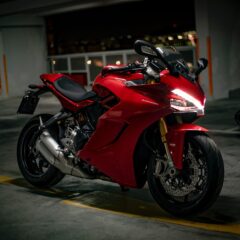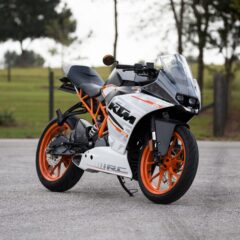
7 Top Motorcycle Accessories
With Christmas just around the corner, you might be wondering what to get your favourite motorcycle enthusiast or even a little something for yoursel...
 Phoenix Motorcycle Training LTD
Phoenix Motorcycle Training LTD
 Phoenix Motorcycle Training LTD
Phoenix Motorcycle Training LTD

Learning how to ride a motorcycle in traffic is, of course, part of your licence training. However, learning to ride well — and safely— doesn’t stop when you get your licence. As you gain experience you’ll get better at spotting and avoiding dangerous situations.
To gain that experience, you’ll need to ride in traffic. When roads are busy and slow or moving fast, it can be unnerving for a motorcyclist. After all, you’re the smallest vehicle on the road. Other road users may miss your presence, not know that filtering is legal, or simply become aggressive if they’re stuck and riders are still moving.
Whether you’re using a motorcycle as your main transport or as a weekend rider, rider awareness is crucial. Our tips for riding motorcycles in traffic will keep you safe.
UK roads are, of course, governed by road rules and traffic regulations. Every person on the road has passed a test to prove they are aware of them. Road rules give riders and drivers a certain level of predictability and guidance for engagement. This helps us all to understand what other road users are doing and reduces the chance of misunderstandings.
But they aren’t the only language of the road. Our gestures, the speed we choose and the position we adopt on the road all indicate to other road users what we are doing. It also indicates what we are planning to do. This second non-verbal road language, allows each person on the road to loosely work as a team. It helps every one to get where they want to go safely and without incident.
When riding or driving in traffic, to see and be seen by others equates to understanding and being understood by others. A great example of this is when approaching a pedestrian crossing where someone is waiting to cross. Gradually slowing down, catching the eye of the pedestrian and maybe giving them a brief nod lets them know you have seen them. It also conveys that you are intending to let them cross.
As the smallest vehicle on the road, it is important to always invite other road users into the unspoken language of the road. Do this with deliberate gestures, how you position your motorcycle and never taking for granted that others will join you in this silent conversation. This simple approach for how to ride a motorcycle in traffic is one of the most important for keeping you safe. And it’s an important conversation for you to have when you’ve got a pillion passenger to think about too.
One of the main challenges for motorcyclists is spotting, understanding and mitigating risks. Your early days of motorcycle training will have prepared you with rider routines. The OSM routine (observe, signal and manoeuvre) and the PSL routine (position, speed and look) is all about seeing, understanding, deciding and acting appropriately. To act, you must be prepared.
Preparation can be as simple as moving two fingers to your brake lever when you notice something dangerous. Or maybe creating a safety zone around your motorcycle that gives you room to correct your own or others’ mistakes. Lack of preparation leads to a lack of time for action. Always be attentive to the space and time you need to perform the necessary actions.
Muscling in to create space on the road isn’t an option when you ride a motorcycle in traffic. As the smallest vehicle on the road, you need to rely on actively participating in your transport. That means having total control over your machine so you can get it exactly when it needs to be when it needs to be there. The worse your rider technique is, the harder this will be.
Thinking ahead will enable you to create the time and space needed to be ready for the dynamic nature of UK traffic. Time allows space. Being in the right place at the right time is essential for a motorcyclist. The right space is all about not being in the same spot as another road user.
Always ensure you have the space and opportunity to perform the actions you want to rather than letting other drivers decide for you. Visibility, safety distance and the necessary time and space to correct missteps and errors are key.
It can be difficult to understand why other drivers simply don’t see you — particularly if you are a new rider. It’s important for motorcyclists to do all they can to be seen on the road. One way to do this is by choosing your position on the road.
For example, if deciding to overtake on the motorway you won’t simply throw yourself into the right lane and accelerate. Instead, you’ll indicate with lights, positioning and behavioural gestures what you are planning to do. This means accelerating slowly in the left side lane, moving towards the centre line and sitting there for a second or two to double-check blind spots before changing lanes.
This deliberate action lets other road users know what you are intending. It enhances visibility and creates predictability. That invites other road users into the unspoken conversation of road use. Similarly, when riding behind other traffic, ensure the driver can see you in their mirrors.
High visibility clothing, the use of lights and brightly coloured motorcycles can help, but deliberate riding behaviour mustn’t be ignored. Well thought-out riding style allows you the chance to make alternative manoeuvres and if a hazard arises, revert to a plan B.
No one likes being stuck in a traffic jam. In the UK, it is legal to ‘filter’ through still or slow-moving cars. However, this can be a risky choice, particularly if you lack good riding technique, strong nerves and a high level of attention.
It is also worth noting that drivers stuck in traffic are often frustrated and this frustration easily turns to aggression. This aggression can manifest as blocking motorcyclists trying to filter through slow-moving traffic. Using a high-beam headlight on your motorcycle will improve visibility, but it is not to be relied upon alone.
Filtering is best practised at low speeds of around 30 to 40 mph. There is no shame in deciding to stay in the queue of traffic, albeit a little boring and time-consuming!
Knowing how to ride a motorcycle in traffic safely is one thing. Putting these tips into practice is another. We’d recommend consciously practising your motorcycle technique at every opportunity available so that it becomes second nature. Paying a high level of attention to what the traffic is doing, how other road users are behaving, and doing your utmost to be predictable, seen and friendly towards other road users will keep you safe out there. Happy riding!

With Christmas just around the corner, you might be wondering what to get your favourite motorcycle enthusiast or even a little something for yoursel...

If you love motorcycle riding, you’ve probably daydreamed about riding a motorbike for a living. A professional racer or stunt rider is OK for some...

Getting a UK motorcycle licence can seem a complicated process. Particularly when compared to a driving licence for a car. Whether you choose the pro...
This website uses cookies to personalise content, ads, and analyse traffic, sharing data with partners who may combine it with other information. See our Privacy Policy for more information.